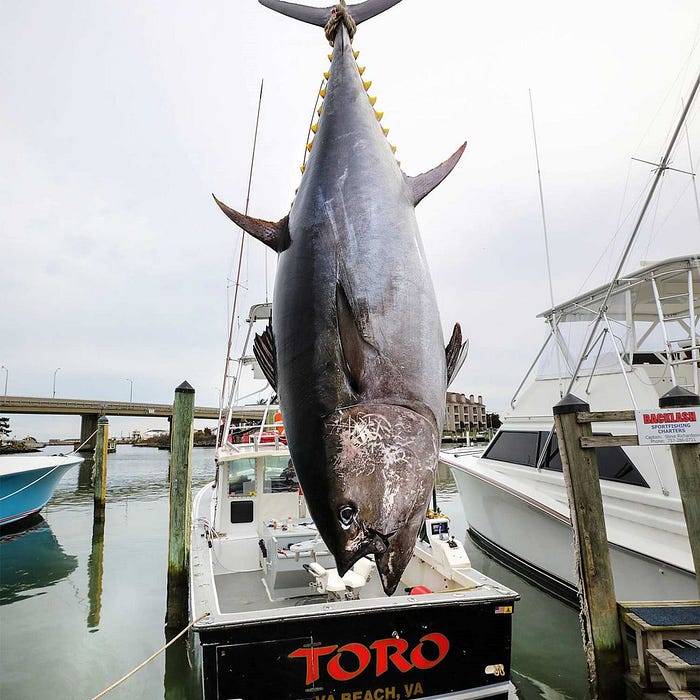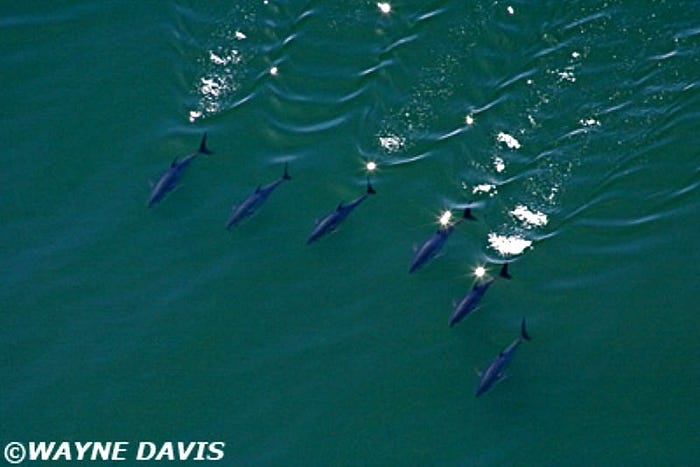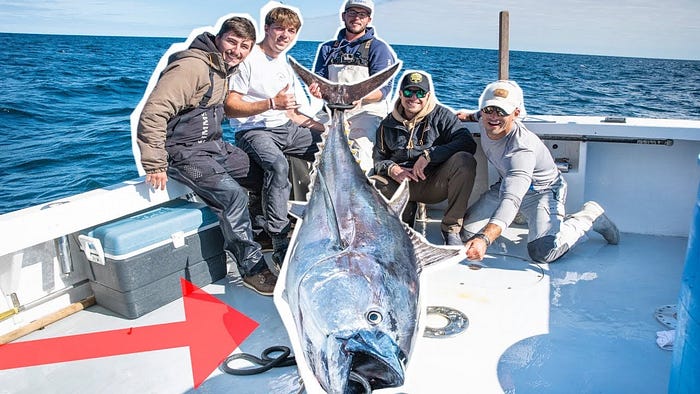Don’t Eat Tuna: We are killing the ocean’s most effective predators


Please scroll all the way down to see an update on the situation with tuna populations and sustainable harvest.
Tuna are some of the ocean’s most impressive and stunning predators, but it is likely many people devour these creatures without a second thought. The commercial fishing industry is quickly driving this species to extinction, and without tuna the ocean’s ecosystem will be wrecked. Most tuna species are apex predators and are amazing predators. Like most other large pelagic fish they are fast and agile, especially bluefin tuna. They can dart at speeds of up to 25 miles an hour and can leap out of the water after smaller fish.
What makes them so important to the environment is their ability to hunt in colder waters. Since they are warm-blooded creatures, they can manage their body temperature and hunt farther north than most other large pelagic fish like the marlin, dolphin-fish (also called the dorado or mahi-mahi), giant trevally, and tarpon. This makes them the main predator of schooling fish in places like the North Atlantic. They also are usually the fish that form the bait ball since dolphins usually can’t dive deep enough so they follow the tuna to help them once the fish are near the surface. Without bait balls, many sea birds wouldn’t have any food. Without tuna, all of the cod, seals, and a few humpback whales wouldn’t be able to manage the population of schooling fish (like capelin, sardines, and herring). An over-population of those fish could lead to very little krill being left for large animals like baleen whales to eat. While some baleen whales can eat fish, some don’t and those will die first. The lower amounts of krill mean the fish who eat them will eventually die out or have a steep population drop leaving the whales to die. Whales act as large carbon sinks so having them around is important for humans as well. Not only do tuna eat fish, but they eat jellyfish as well. Many scientists warn that without tuna, there will be an overpopulation of jellyfish. Tuna are one of the few animals that eat jellyfish as the jellyfish have venom and low nutritional value. There are some species of jellyfish that do not have venom but have nearly zero nutritional value, so tuna just eat them along with the schooling fish they eat.


While fish are generally not considered “intelligent”, tuna have some of the most coordinated attacks of all fishes. They are usually the fish to create a bait ball and then attack, then trigger insane feeding frenzies. They rush in while in formation and attack the fish. The pictures shown here display the coordination and intelligence of these fish. They are thought to use signals when hunting (such as flashing their scales into the sun) to tell other members of the pod what to do. These animals are such important species to the environment, not only due to their diet but they also serve as a good meal for any predator which is smart, powerful, and fast enough to over-power them. Great White Sharks usually eat tuna and a drop in the tuna population will result in many more sharks swimming to the coast to attack seals. With more sharks hunting seals near the coast, shark attacks will be happening much more often as hungry great white sharks start patrolling the coasts.
Several other species of tuna are at risk as well. Big-eye tuna are decreasing at an alarming rate and are classed as Vulnerable (that is the same conservation status as Komodo Dragons and African Lions). Species like the albacore and the yellowfin tuna are classed as Near Threatened and are having a large drop in their population. Fishing industries try to say that the populations are “stable” but they are still dropping and this level of harvesting fish can not continue.

This way of harvesting tuna is not sustainable. The sheer amount of fish harvested is too much for there to be a stable population. Population counts, while pretty accurate, are deceptive and flawed. When you check a population of tuna, you look at fish of all ages. This is bad because most of those fish are near-microscopic fry drifting in the currents with the plankton and almost all of those little fish are going to get eaten by predators like the schooling fish that their parents eat.
Many people undermine how bad this situation can be. The populations are at extremely dangerous levels and without these tuna holding the food chain together, the ocean will be a mess. They also contain high levels of mercury along with other chemicals. This is because of biological magnification which means any toxins ingested by the little fish get magnified as you go up the food chain. Since tuna are at the top or near the top of the food chain they have insane levels of these toxins. It is simply not good to eat them regularly, for the environment and your own personal health. If you want to get fish, try farmed tilapia or trout. In the USA and parts of Europe, you can usually find creeks that have been stocked (had non-native or common fish released into them) which you can catch and eat. You simply can’t sustainably farm tuna because they are pelagic fish meaning they need lots of space and special food.

Commercial fishing is not the only threat to tuna. Recreational fishermen often want to eat their catches. This is horrible for the population as they prefer to catch the largest fish. Larger fish lay more eggs and are more beneficial to the population so taking them out reduces the population by large numbers. Recreational fishing in spawning areas is also horrible for the fish because the stress of spawning and then being pulled up by a rod is too much for some tuna and they just don’t spawn that year. The tools used by most tuna anglers usually force them not to release the fish, one example being the gaff. Gaff sticks give the fish deep wounds and injuries usually severely injuring the animal or killing it.
Tuna fishing not only catches tuna but other species of animals too. This is called “by-catch” and they often get stuck in the giant tuna nets. Examples of species affected by these are dolphins, sharks, and sea turtles. The nets are a death sentence to any animal in them. If the suffocation doesn’t kill them, the stress usually will.


The issue is that people don’t view bluefin tuna on the same level as other creatures. If you shot a raccoon to eat it you would get loads of internet backlash even though they aren’t endangered and the shot was humane. On the other hand, if you gaff a bluefin tuna which is an endangered species, you would be congratulated even though you left the animal to slowly bleed and suffocate to death.
Farming tuna is not sustainable either. Most tuna farms take juvenile tuna and fatten them up to be harvested. Raising tuna is hard because they require lots of food, being so near the top of the ocean food chain. Raising tuna is simply like raising jaguars for food. Both animals have lots of meat on them but they both require a lot of food. Tuna meat gives you fewer calories than the amount of fish they would be eating. It is simply not sustainable and hides under the guise of responsible farming. They are putting an entire ecosystem at risk and the population of tuna is close to its breaking point, and then we would have lost this giant predator from our oceans. The food chain in the ocean would be an absolute mess, and we would be responsible.


So is there hope? Yes, there are industries that could save these amazing fish and still be profitable for the companies, the scuba and eco-tourism industries. Shark diving used to be rare and was almost always conducted in a cage but free-diving with sharks gave society a new look at these creatures. It was concrete evidence that sharks weren’t blood-thirsty predators always trying to rip your arms off. This new respect for sharks not only brought in donations but gave several people new jobs, showing people how to dive with sharks. Tuna could be just like that, they are similarly impressive being giant predators and they often make giant bait balls which would be insane to witness first-hand. Their sheer intelligence and power would give us a new look at this creature most of us considered as nothing but a meal.
UPDATE: This post was written before a recent re-evaluation of tuna populations by IUCN. Thanks to conservation measures, populations of most species of tuna have significantly risen. We still can’t let our guard down, we can easily destroy tuna populations. If you plan on eating tuna, check with the Monterey Bay Aquarium Seafood Watch to make sure you are buying sustainably harvested tuna. I do believe this resource can be managed sustainably, but we have to avoid unsustainably caught tuna at all costs. We don’t want to lose these fish that are so important to the open ocean ecosystem.